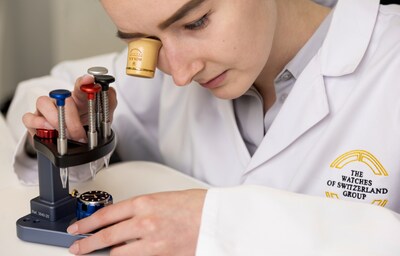Journey of a watchmaker: Interview with Louise Duffield

At the Watches of Switzerland Group, we are proud to be at the forefront of luxury watch retail. While our showrooms display exceptional timepieces, the true craftsmanship happens behind the scenes, where our expert watchmakers dedicate their skill and precision to keeping our cherished timepieces ticking.
In this series, we delve into the world of watchmaking with some of our in-house experts, who explain how they came to work in the industry and share valuable insights on their craft. First, we speak to Louise Duffield, a Rolex-trained watchmaker at Watches of Switzerland’s National Service Centre in Manchester.
Could you tell us how you became a watchmaker?
My journey into the profession was very lucky. I was medically discharged from the army and still on crutches just two weeks prior to having an interview to become a battery technician at my local Goldsmiths. I have an engineering degree and was a vehicle mechanic in the army, so I have a technical background, but I had no clue about watches! After around three months, my name was put forward to do an after-sales service watchmaker course with Rolex, and it’s just grown from there.
Can you explain what becoming a Rolex-trained watchmaker entails and highlight any key milestones in your career that contributed to this accomplishment?
I was one of the first external candidates outside of the Rolex branch to do the course with the brand, so that felt like a real milestone. On the technical side, my training means I can now service and refurbish the professional Rolex models, like the Rolex Explorer II, the Rolex GMT-Master II and the Rolex Submariner.
What does a typical day look like for you at Watches of Switzerland, and what challenges do you come across?
It depends on the workload, but we typically work on two watches a day and aim to have them completed by the end of the day, depending on what needs solving. By the end of the week, we aim to have around ten watches completed.
The biggest challenge is problem-solving. With this job, you are constantly learning, and there’s always something new or different to fix. We have to diagnose and solve intricate issues efficiently.

Are there any specific models that are particularly difficult to work on?
The Rolex GMT-Master II can be more challenging than some of the other models due to the complexity of the movement. The Rolex Cosmograph Daytona also presents a good challenge to work with because of the complexity of its mechanism and how delicate the materials are.
What advice would you give to someone looking to break into the industry?
Show a lot of patience to continue to learn! And, more importantly, develop a passion for it, because if you don’t have passion then you’ll struggle to push yourself to overcome the challenges you’ll face. It can take years before you learn the brand accreditations, but perseverance pays off in the long run. Also, your dexterity is crucial; you can’t fix a watch with shaky hands, so it’s also worth avoiding too much coffee!
Are there any specific courses or apprenticeships you’d recommend for aspiring watchmakers?
Oh yes, there are quite a few. I’d say the WOSTEP course, which is now located in Stockport, is a great entry point for anyone looking to break into the industry. The WOSTEP Foundation is an independent watchmaking institution that’s supported and recognised by members of the Swiss watchmaking industry, so it provides an excellent foundation for this.
Finally, what are your long-term career goals – is there a particular watch you’d like to own one day?
My aspiration is to eventually work in a Geneva workshop – I had originally planned to complete my certification there, but those plans were disrupted by the pandemic. Hopefully one day I’ll get to Switzerland! And as for a dream watch, I was introduced to a specific platinum Rolex Cosmograph Daytona featuring an ice blue dial during my course, and I simply fell in love.